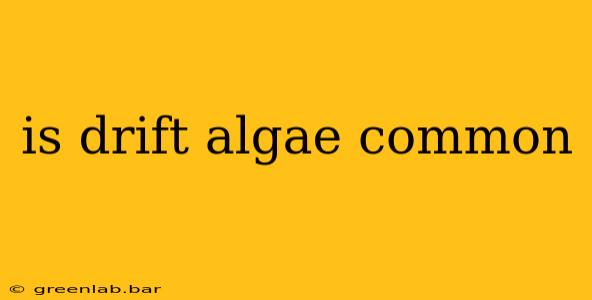Drift algae, those unsightly mats of seaweed and other aquatic plants that accumulate along shorelines and clog waterways, are unfortunately a fairly common occurrence in many aquatic environments. While not always a major problem, understanding the factors contributing to its prevalence and the potential consequences is crucial for both environmental health and recreational enjoyment.
What Causes Drift Algae Blooms?
Several factors contribute to the frequency and severity of drift algae blooms. These often interact in complex ways, making it challenging to pinpoint a single cause.
Nutrient Enrichment (Eutrophication):
This is perhaps the most significant contributing factor. Excess nutrients, primarily nitrogen and phosphorus, from sources like agricultural runoff, sewage treatment plants, and stormwater drainage, fuel the rapid growth of algae. This process, known as eutrophication, creates a nutrient-rich environment that allows algae populations to explode.
Water Temperature:
Warmer water temperatures generally promote faster algal growth. Climate change, with its associated rising temperatures, may exacerbate the problem, leading to more frequent and intense blooms.
Water Flow and Movement:
Stagnant or slow-moving water bodies are more susceptible to drift algae accumulation. Areas with limited water circulation allow algae to congregate and form dense mats. Conversely, strong currents can help disperse the algae, minimizing the formation of large accumulations.
Sunlight Availability:
Sufficient sunlight is essential for photosynthesis, the process by which algae produce energy. Water clarity plays a role; excessive turbidity (cloudiness) can limit sunlight penetration and hinder algae growth.
Species Composition:
The types of algae present in a water body influence the likelihood and characteristics of drift algae formation. Certain species are inherently more prone to forming large, detached mats than others.
Is Drift Algae Harmful?
While not inherently toxic, large accumulations of drift algae can have several negative consequences:
Ecological Impacts:
- Reduced oxygen levels: Decomposing algae consume oxygen, potentially leading to hypoxic (low-oxygen) or anoxic (oxygen-depleted) conditions harmful to fish and other aquatic organisms.
- Habitat degradation: Thick mats of algae can smother submerged aquatic vegetation, disrupting aquatic ecosystems and reducing biodiversity.
- Harmful algal blooms (HABs): Some algae species produce toxins that can be harmful to humans, animals, and the environment. While not all drift algae are toxic, the potential for HABs needs to be considered.
Recreational Impacts:
- Reduced water quality: Drift algae can make water unpleasant for swimming and other recreational activities.
- Obstruction of waterways: Large accumulations can impede boating and other water-based activities.
- Unpleasant odors: Decomposing algae can produce foul-smelling gases.
Managing Drift Algae
Managing drift algae often requires a multi-faceted approach that addresses the underlying causes:
- Nutrient reduction: Implementing strategies to reduce nutrient runoff from agricultural lands, urban areas, and wastewater treatment plants is critical for long-term control.
- Improved water management: Improving water flow and circulation in stagnant areas can help prevent algae accumulation.
- Mechanical removal: In some cases, physical removal of algae may be necessary, but this is often a temporary solution and needs careful consideration of the environmental impacts.
- Biological control: Introducing or enhancing populations of algae-eating organisms can help control algae growth.
Drift algae is a complex issue with no single easy solution. A comprehensive understanding of the contributing factors and a proactive management strategy are essential for mitigating its negative impacts and maintaining healthy aquatic environments. The frequency of drift algae varies considerably depending on geographic location and environmental conditions. Consulting with local environmental agencies or experts can provide tailored advice for specific situations.

